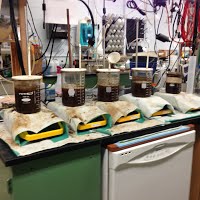PHA Reactor
The purpose of the PHA reactor is to synthesize PHA compounds from the volatile fatty acids (VFAs) produced in the fermenter. The PHAs are the precursor of some forms of bioplastics. This is accomplished by bacteria, which produce PHAs because they are a form of carbon and energy that can be stored for later. It is synthesized when carbon in the reactor is in excess but another necessary nutrient is lacking. When that nutrient is available again, the bacteria then degrade the PHA compounds and use the energy. This is called the feast/famine method of PHA synthesis, and the PHA should be harvested when it is in excess in the reactor.
The specific PHA polymer of interest in this process is PHBV (polyhydroxybutyrate-co-valerate). This is a polymer comprised of two PHA compounds: PHB and PHV. The polymer is desirable because the compounds by themselves have some material properties that make them unsuitable for large commercial use. PHBV has potential for use in biodegradable films, utensils, and medical applications.1,2,3 PHBV with 10% PHV content has properties similar to the plastic in milk jugs (HDPE), while PHBV with 20% PHV content has properties similar to the plastic that makes up flexible films (LDPE). Most of the VFAs added to the reactor are converted to PHA compounds, so it is a generally efficient process. In addition to the desired product of bioplastic compounds, there is a liquid byproduct. This product is rich in nutrients, so it may be cycled back to the photobioreactor to serve as a source of nutrients for the algae.
 |  Products from PHA reactor Products from PHA reactor
|
| Laboratory-scale PHA reactor | PHA-producing microorganisms4 |
1Anon (1989). Modern Plastics Encyclopedia. 11 edn. McGraw Hill Inc., NY.
2Madison L.L. and Huisman G.W. (1999). Metabolic engineering of poly (3-hydroxyalkanoates): from DNA to plastic. Microbiol. Mol. Biol. Rev., 63, 21-53.
3Zinn M., Witholt B. & Elgi T. (2001). Occurrence, synthesis and medical application of bacterial polyhydroxyalkanoate. Advan. Drug Deliv. Rev., 53, 5-21.
4Endres, H. J., and A. Siebert‑Raths, 2011,
Engineering Biopolymers, Hanser Publishers, Cincinnati, OH.

